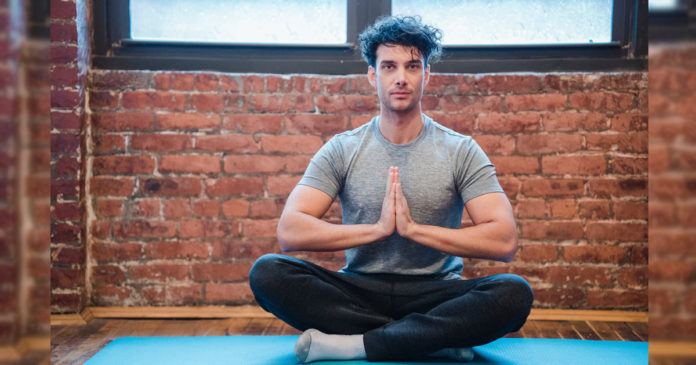Welcome to the realm of open-eyed meditation! Although many of us are acquainted with the conventional practice of shutting our gaze when we meditate, there is rising interest in investigating the idea on how to meditate with eyes open. This unusual method of mindfulness practice may be a beneficial supplement to your meditation skills.
As the name implies, the process to meditate with eyes open entails keeping your eyes half or completely open throughout your meditation session. It helps you to be aware of your environment while maintaining a contemplative state. This technique is especially good for people who have difficulty shutting their eyes owing to pain or find it difficult to concentrate during conventional closed-eye meditation.
By engaging in a method that enables you to meditate with eyes open, you may incorporate mindfulness into regular tasks and circumstances when shutting your eyes might be inconvenient or dangerous. It allows you to bring a feeling of calm and presence to situations like commuting, working, or engaging with people.
The Benefits of Meditating with Eyes Open
Meditation is often linked with shutting our eyes and looking inside, but another technique that is gaining popularity is to meditate with eyes open. Although it may seem contradictory at first, this strategy has distinct advantages that might improve our attention in daily life.
Improved attention and concentration are two of the key benefits when you meditate with eyes open. Remaining vigilant and involved in our environment can be achieved by maintaining an open line of sight. This increased consciousness enables us to maintain complete presence and engagement in the current moment, regardless of whether we are engaged in meditation or performing routine tasks.
Furthermore, if you meditate with eyes open, it helps us to create a better feeling of attention throughout the day. We learn to incorporate this level of being aware into all parts of our life as we get used to meditating with our eyes open. We begin to notice the nuances of our surroundings—the colors, forms, and movements—and develop a new respect for what is happening around us.
Aside from these advantages, when you meditate with eyes open, it may serve as an easy reminder to maintain a healthy balance of inner thought and exterior participation. It helps us to establish a balance between reflection and active participation in the world.
Investigating the advantages of practicing mindfulness when you meditate with eyes open can offer a novel viewpoint, notwithstanding the merits of closed-eye meditation. It’s a chance to sharpen our concentration, become more aware of the world around us, and bring more present to every moment.
Techniques for Practicing Meditation with Eyes Open
While many people equate meditation with shutting one’s eyes and attaining inner peace, there are strategies for practicing meditation while keeping one’s eyes open. Methods of open-eye meditation provide a unique way to foster awareness and attention while connecting with the outside world.
The gentle gaze approach is one prominent technique. Rather than focusing on a single point, you let your attention take a break on an impartial thing or area toward you. This helps you to be aware of your environment while also focusing your attention within.
Candle flame meditation is another method. You can fix your attention and attain a state of profound relaxation by concentrating on the gradual flicker of a candle flame. The flame acts as a visual focus, assisting in the quieting of the mind and the cultivation of inner serenity.
Natural landscape meditation may be quite useful for individuals who love to connect with nature. Find a quiet outdoor space and let your eyes softly sweep the scenery. Take in the textures, hues, and motions around you while keeping your respiration and body sensations open to you.
Meditation with your eyes open might be particularly beneficial for those who experience lethargy or feel detached while the eyes are closed. These approaches allow you to incorporate mindfulness into your everyday life by accepting both internal and external events.
Meditate with Eyes Open: Tips for Success
To meditate with eyes open may be a great technique for creating a calm but attentive state of body and mind. It is essential to establish a good setting and follow certain crucial principles to guarantee a successful session.
To begin, select a calm and serene location where you will not be readily distracted. Select a sitting position that enables you to keep your back straight without effort.
Find a focus point when you meditate with eyes open. It might be a candle fire, an intricately detailed item, or simply a patch on the wall. The goal is to possess something that draws your attention without generating eye strain or discomfort.
Gently rest your eyes on your focus point after you’ve located it. Allow oneself to become totally involved with the moment by softening your concentration. Instead of gazing or pushing your eyes to remain focused, let them relax spontaneously as they absorb in the visual input.
Remember to maintain a calm but aware state of mind and body while you proceed with open-eye meditation. Allow any ideas or distractions to come and go without judging or attachment. When you sense your attention straying, bring it back to the focused subject.
Finally, be kind with yourself while you experiment with this exercise. Open-eye meditation may seem strange at first, but with consistent practice, it may become extremely enjoyable. Accept the path of self-discovery and benefit from the increased concentration, relaxation, and awareness that this approach may provide.
Note that individual experiences when you meditate with eyes open may differ significantly, so feel free to modify these suggestions based on what’s working best for you.
Combining Closed-Eye and Open-Eye Meditation for a Balanced Practice
Beyond the typical closed-eye practice, there are several approaches for meditation that may be studied. For a more well-rounded practice, one might alternate between open-and closed-eye meditation.
While closed-eye meditating allows for profound introspection and concentration on inner feelings, open-eye meditation adds an exterior component to the practice. By rotating between these two strategies, practitioners may get a range of advantages and improve their entire meditation experience.
Closed-eye meditation allows you to focus inside, disengage from outside distractions, and build awareness. It enables people to more clearly examine their ideas, feelings, and experiences. Open-eye meditation, on the other hand, draws attention to the moment at hand by interacting with the external world. It teaches practitioners to view their environment objectively and without attachment.
Individuals may achieve an equilibrium between reflective thinking and a relationship with the outside world by including combined closed-eye and open-eye practices into their practice. This combination provides a comprehensive approach that encourages introspection as well as being aware of one’s surroundings.
By alternating between open-eye and closed-eye meditation, one can further diversify their practice. Diverse stimuli are introduced during each session to prevent monotony and maintain mental engagement. This variety contributes to the practice’s long-term sustainability by sustaining interest over time.
Combining open-eye and closed-eye meditation techniques, in summary, provides a well-rounded approach to cultivating mindfulness. Practitioners may enhance their awareness of themselves while remaining connected to their environment by embracing both reflection and involvement with the external world. So, why not try this dynamic combination of approaches for a more rewarding meditation experience?
Incorporating Open-Eye Meditation into Daily Life: Practical Applications and Integration
If you meditate with eyes open on a daily basis, it can have a profound impact by infusing our activities with mindfulness and consciousness. We may create a feeling of presence and connectedness to the present moment by including small periods of mindfulness throughout the day.
Bringing attention to tasks like walking or eating is one practical use when you meditate with eyes open. Instead of hurrying through these duties on autopilot, we may slow down and immerse ourselves in the experience with all of our senses. By directing our focus towards the tactile and gustatory experiences of our food, as well as deriving pleasure from these ostensibly ordinary pursuits, we can augment our general state of being and imbue them with an even greater sense of delight.
We may break away from the continual stream of ideas and distractions that frequently control our attention by including small periods of mindfulness throughout the day. By pausing momentarily, inhaling deeply, and tuning into our surroundings, we can assist in becoming more grounded in the present. Whether it’s recognizing the warmth of sunshine on our skin or paying close attention to the noises around us, these simple moments of mindfulness may have a significant influence on our general mental sharpness and emotional well-being.
It is not sufficient to set aside time exclusively for formal practice in order to incorporate open-eye meditation into our daily lives; rather, we must strive to integrate mindfulness into each and every aspect of our beings. We may create a greater feeling of appreciation, curiosity, and empathy for ourselves and everything around us by being completely present in each moment.
Conclusion: Embrace the Power of Meditating with Eyes Open to Deepen Your Mindfulness Practice
Finally, accepting the potential to meditate with eyes open may significantly strengthen your mindfulness practice. You may build a feeling of awareness and involvement in your everyday life by having the eyes open during meditation.
While conventional meditation methods often entail shutting one’s eyes, meditating with one’s eyes open helps you to incorporate awareness into your daily activities. It allows you to be present in the moment while connecting with everything that is around you.
You may improve your capacity to stay focused in the face of distractions and problems by practicing this kind of meditation. It aids in the development of a more adaptive and flexible thinking, helping you to manage varied circumstances with clarity and calm.
Don’t be frightened to attempt meditation while keeping your eyes open. Accept this powerful approach as a tool to enhance your meditation practice and bring more awareness into your life.










